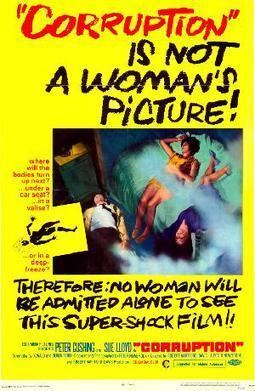Corruption (1968 film)
8 /10 1 Votes8
Duration Language English | Country United Kingdom | |||||||||||||||||||||||||||||||||
 | ||||||||||||||||||||||||||||||||||
Release date December 1968 | ||||||||||||||||||||||||||||||||||
Corruption 1968 trailer
Corruption is a 1968 British horror film directed by Robert Hartford-Davis, from a screenplay by Derek Ford and Donald Ford, and featuring Peter Cushing, Sue Lloyd, Noel Trevarthen, Kate O'Mara, David Lodge and Antony Booth.
Contents

The film is a loose riff on the plot of the 1960 French horror film Eyes Without a Face, and is notable for its atypical contemporary setting (most of Cushing's Gothic Horror films were set in the past) and its extreme (for the time) gore and violence.
Plot
Sir John Rowan (Peter Cushing) is a prominent plastic surgeon with a beautiful and youthful fiancée named Lynn (Sue Lloyd), who works as a fashion model. At a raucous party, Rowan—much older than any of the other attendees, and clearly uncomfortable around the countercultural excess of the late 1960s—gets into a physical altercation with a sleazy photographer, and during the scuffle a hot lamp falls on Lynn, severely scarring her face. Rowan pledges to reverse Lynn's disfigurement, experimenting with laser technology to revive her skin and eventually coming up with a cure-all, a Frankensteinian transplantation of glands. Driven by a combination of guilt and love, Rowan goes on a murder spree, killing young women in order to use their glands to restore his fiancée’s beauty. The procedure is successful, and the couple goes off on holiday to a seaside cottage, where all is fine until her face starts to show signs of deterioration.
In need of more surgery and a new "donor" the couple tries to entice a young girl (Wendy Varnals) who they meet at the beach and take back to their cottage. Complications ensue, first because Rowan doesn't want to commit another murder, and then because this girl isn't what she seems to be. In fact, she is part of a gang of robbers who break into the house and hold Rowan and Lynn hostage. Soon they discover evidence of the murders, and begin to menace the couple. After a short confrontation, everyone is killed when Rowan's surgical laser goes out of control.
The films ends with the revelation that everything from the disfigurement onward seems to have been a dream experienced by Rowan at the party.
Cast
Production
The film was shot at Isleworth Studios, and on location at Hope Gap Beach in Seaford, East Sussex.
Due to the strong graphic content of the film, different markets around the world received different versions of key scenes, most notably the murder of a prostitute who appears topless in some markets (Scandinavia, South America, and East Asia) but is clothed in the version which played in the UK and USA. The two versions feature different actresses in the role, as well as different dialogue.
Cushing would later comment, "It was gratuitously violent, fearfully sick. But it was a good script, which just goes to show how important the presentation is. The company that made the film split up halfway through as certain individuals could not agree on what should and should not appear in the final print. What you saw was the final result of their bickering. Audiences did not get the idea that it was supposed to be based on a dream, which in fact did not justify some of the scenes that were presented. With any film you participate in, the company, if they so wish, can destroy your original interpretation of the role."
Reception
The film was negatively received at the time of its release; Vincent Canby of the New York Times noted that "Peter Cushing ... brings a certain seedy grandeur to the role," but dismissed the film as "silly," particularly due to the contemporary setting. A review in Variety called it a "Fair horror picture ... [that] suffers from poor writing, plus often sluggish direction."
The film has been better received in recent years as a cult film, sometimes enjoyed for its camp value. Of modern critics:
Brian Orndorf of Blu-ray.com writes in his 2013 review, "This 1968 film is set during the Swinging London period of gaudy liberation, where colors exploded, hair was uncomfortably cut, and free love was rampant. The image of Cushing, with his gentlemanly manner and impeccable style, is a potent one in the midst of all the youthful madness, with the opening of the effort traveling to a boisterous party where John is cornered by a picky hippie while Lynn's photographer guru goads her into nude shots. Corruption quickly moves away from the freak-out showdown, but its period fashion sense remains, lending the movie a distinct look that's almost as entertaining to study as the murder spree ... Corruption finds a pitch of cinematic madness and holds there for most of the picture, remaining taut, with a pinch of sleaze for seasoning."
Critic Paul Chambers writes, "Silly, but entertaining. That’s the best way to describe Corruption, the story of a wealthy surgeon during the swinging 1960s who would do anything to keep his young girlfriend happy ... Corruption is a hoot. It was made in the late 1960s and authentically depicts London’s free love and hip culture that was later lampooned in the Austin Powers comedies. Only this film was intended to be a serious horror flick and the costumes and sets are all that more enjoyable because ... well, just because. Peter Cushing is over-the-top crazy in this grindhouse-style goreathon. It’s hard to imagine the filmmakers didn’t know the end product would be campy. But, that makes little difference to today’s audience. I see Corruption as a time capsule, of sorts."
"Probably the imperfect jewel of British director Robert Hartford-Davis's oddball filmography ... Corruption had been perhaps the rarest of horror superstar Peter Cushing's many, many genre movies until the October appearance of this beautifully remastered and restored edition from Grindhouse Releasing, a company that exceeds even the Criterion Collection in its determination to create the definitive editions of the titles it licenses ... A truly wacked-out work of art," writes critic John Beifuss.
